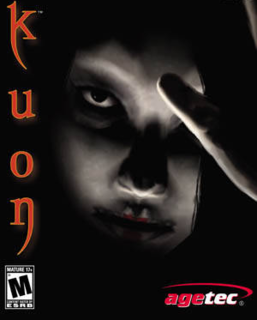Kuon is a very different survival horror game that is not for everyone, but it’s an great game regardless.
Kuon is the story of two women, one a disciple of Doman, a powerful civilian exorcist of dubious character, and the other is one of his daughters. The first girl, Sakuya, is instructed by Doman to come to Fujiwara manor along with Doman’s other students to investigate why the manor has become overrun with demons. The second, Utsuki, seems to have picked up some of her fathers magical talents. She has entered the manor with her sister, Kureha, in the hopes of finding their father. The two of them are going to have to brave the hungry dead, ghosts and the diseased residents of the mansion to discover the secrets of the mansion, who these two mysterious singing twins are and to find the source of the evil here.
The storyline is told much in the style of the first two Resident Evil games; there are two characters to control that will adventure through the same areas, with mostly the same story as well as many of the same items and goals. However, the differences between Kuon and Resident Evil are what make this game so interesting. While the two adventures are similar to start, near the end of both, they differ wildly and you must play through both “phases” fully to understand what is going on. The story reaches its completion when you hit the final phase, named the “Kuon” phase. The story is confusing at times, but I found myself having problems putting the game down because I always wanted to know just what was going to happen next. This is especially true in Utsuki’s “Yin” phase. To the observant eye, it is fairly obvious that all is not quite as it seems in this phase, especially if you play it after Sakuya’s “Yang” phase.
The graphics are very good in this game, especially in the cut-scenes. The character models look good, the enemies look suitably creepy, the spells that you use to fight look good as well and the environment is well fleshed out. You will find evidence of death and destruction everywhere and it very much added to the experience for me, although some of the creepy tricks the game uses get way over used before you’ve completed this game. However, there are some problems with the graphics, a few minor problems and a major one. The minor ones include things such as clipping problems, things like your robes passing through objects as you move past them. You will also notice that in many of the fights, it almost seems as if you and your opponents aren’t even coming into contact with each other; you swing and your weapon passes by the enemy but somehow it still hits them. At other times, the same exact swing will miss by about a millionth of an inch and the enemy will get a free hit on you. The major problem with this games graphics is an odd one that could have been simply solved: The characters mouths do not move when they are talking, forcing you to learn the voices of your characters so that you can tell just who is talking whenever a conversation starts. Its annoying, because if their mouths at least flopped about, without any sort of lip synching, then you would know who was talking.
The combat is probably one of the things that most people will either not mind or absolutely loathe. The combat is fairly spastic, that must be acknowledged, but it is fairly forgiving. You can either use your sickeningly weak melee weapon or you can use your spell cards to combat the enemies. These spell cards look like paper talismans and allow you to produce a variety of effects, from throwing a flaming arrow to summoning a living puppet woman to fight for you.
The spell cards are of limited quantity however, meaning you will more than likely save them for the harder enemies. This forces you to use your melee weapon and this is where the combat system breaks down. In melee combat breaks down to an “I hit you, you hit me” sort of thing. Many people balk at this, not liking being hit as much as you will in this game. And you will get hit. Often.
It requires careful maneuvering to avoid trading hits, but it really isn’t necessary. Not only does the game give you plenty of healing items, usually finding a weak healing item on every enemy you fight, but you can heal on your own. There is a meditate button that you can use at any time which will heal you of any status ailments as well as healing your health. It takes some time to do, so it is quite obviously not a thing to be done in the middle of fights, which is where your healing items come into play. However, whenever you have a break from enemies, or you have defeated all the enemies in the room, you do not have to waste any healing items like you would in other games. It’s a nice system that makes the combat system of this game infinitely more forgiving. Without the ability to heal yourself, you would definitely not stand a chance with how the fights go.
Overall, Kuon is a fairly forgiving, somewhat easy, survival horror game that fails in some ways and excels in others. The atmosphere that this game evokes is second only to Fatal Frame and this is one of the strongest points of the game. The storyline is also a strong point, pulling you into it and driving you along. However, not everyone will love this game like I did. It requires a lot of patience to get through the fights without getting annoyed at them. I cannot recommend this game enough to survival horror fans and those who enjoy Japanese horror.
Score: 8/10

